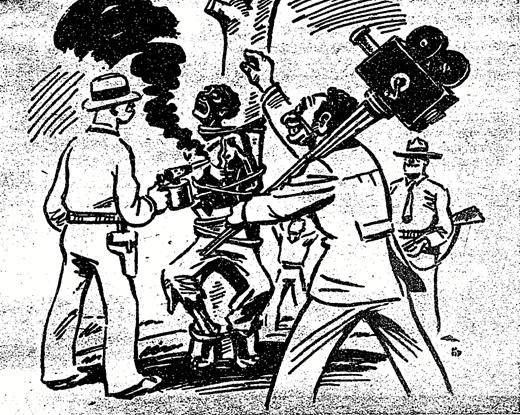This Nazi drawing, reprinted in the New York Times in 1938, highlights how lynching propaganda was used as a strategic tool to expose American hypocrisy while reinforcing discourses on racial inferiority. Note the presence of a Jewish cameraman in the foreground (a symbol of Hollywood, marked by identifiable racialized features such as curly black hair, exaggerated nose and thicker lips). He appears to be directing (supplementing the Hollywood metaphor) the white police officers as they burn a black figure at the state. In the process, the illustrator partially exonerates white Americans from the act of lynching whilst implicated world Jewry as the source of racial violence. Thus, while the illustrator highlights the hypocrisy of America, Jews are depicted as the enablers of lynching in America.
However, Nazi propaganda could never offer genuine sympathy to African Americans. The black figure is an obvious caricature; the oversized lips, harsh lines on the bare chest and ripped trousers emphasising a disfigured and repulsive image of black corporeality. The similarity to the ape-like images in Nazi propaganda on Afro-Germans shows that Nazi propagandists fell short of a true critique of American racism. They implicated Jews in African-American suffering by imagining Jewish control over racial violence while still imagining the black body as grotesque. In so doing, Nazis embraced white Americans’ racial consciousness, even if they criticized its primitive, lawless form.
Ironically, the New York Times writer, Albion Ross, subverts this image. He includes it along with others images from Nazi propaganda which present American life and character to suit the purposes of Nazi ideology. Accompanied with the images is an article criticising the narrow-minded German mentality towards Americans, arguing for America’s “ideological hegemony” and that “attempting to discuss American ideals with most Germans is quite useless.” According to the writer, the propagandist limits American culture to Hollywood and capitalism, particularly evident in the image’s caption “that will make a fine scene”, which Ross sees as a reference to American materialism. Similar to other Nazi propaganda on American culture, criticisms of American culture served as powerful propaganda tools for attacking the racial dysfunction of America, caused by an influence of degenerate races. Ross suggests that, instead of a genuine criticism of America, the cartoon represents the Nazi regime’s attempt to distance itself from American democracy, an ideology which threatens the concept of German racial superiority at the heart of National Socialism. In the process, however, he also sidesteps the cartoon’s depiction of racist terror and violence.
The caricature and this American response illustrate how race and accusations of racism functioned in the international propaganda war.
Niamh Neville
Source: Albion Ross, “Germans Redraw Their Picture of Uncle Sam,” The New York Times Magazine (8 May 1938): 5.
Using lynching in German propaganda (1938) by Niamh Neville is licensed under a Creative Commons Attribution-ShareAlike 4.0 International License. Permissions beyond the scope of this license may be available at https://blackcentraleurope.com/who-we-are/.

